Evaluating Vertical GSHP Performance in Saudi Arabia's Climate
VerifiedAdded on 2023/06/10
|43
|10088
|189
Thesis and Dissertation
AI Summary
This thesis examines the performance of vertical Ground Source Heat Pumps (GSHPs) in the hot and dry climate of Saudi Arabia, aiming to reduce costs, CO2 emissions, and save energy. The study critically reviews existing GSHP technology, presents the concept of GSHP thermal performance, and investigates operational temperatures and heat transfer effects. It analyzes soil heat accumulation in high-temperature regions, estimates total energy savings across a forecast period, and assesses the potential energy savings and peak demand reductions using GHSP systems. The research methodology employs mathematical and numerical analyses, utilizing Ground Loop Design (GLD) programs and TRNSYS simulation software to investigate the impact of weather, soil, and load parameters on GSHP performance, including the vertical separation distance between ground loop pipes under Saudi Arabia's geographical conditions. The study also includes a literature review of energy use history, renewable energy trends, geothermal energy, and the application of ground source heat pumps in similar climates.
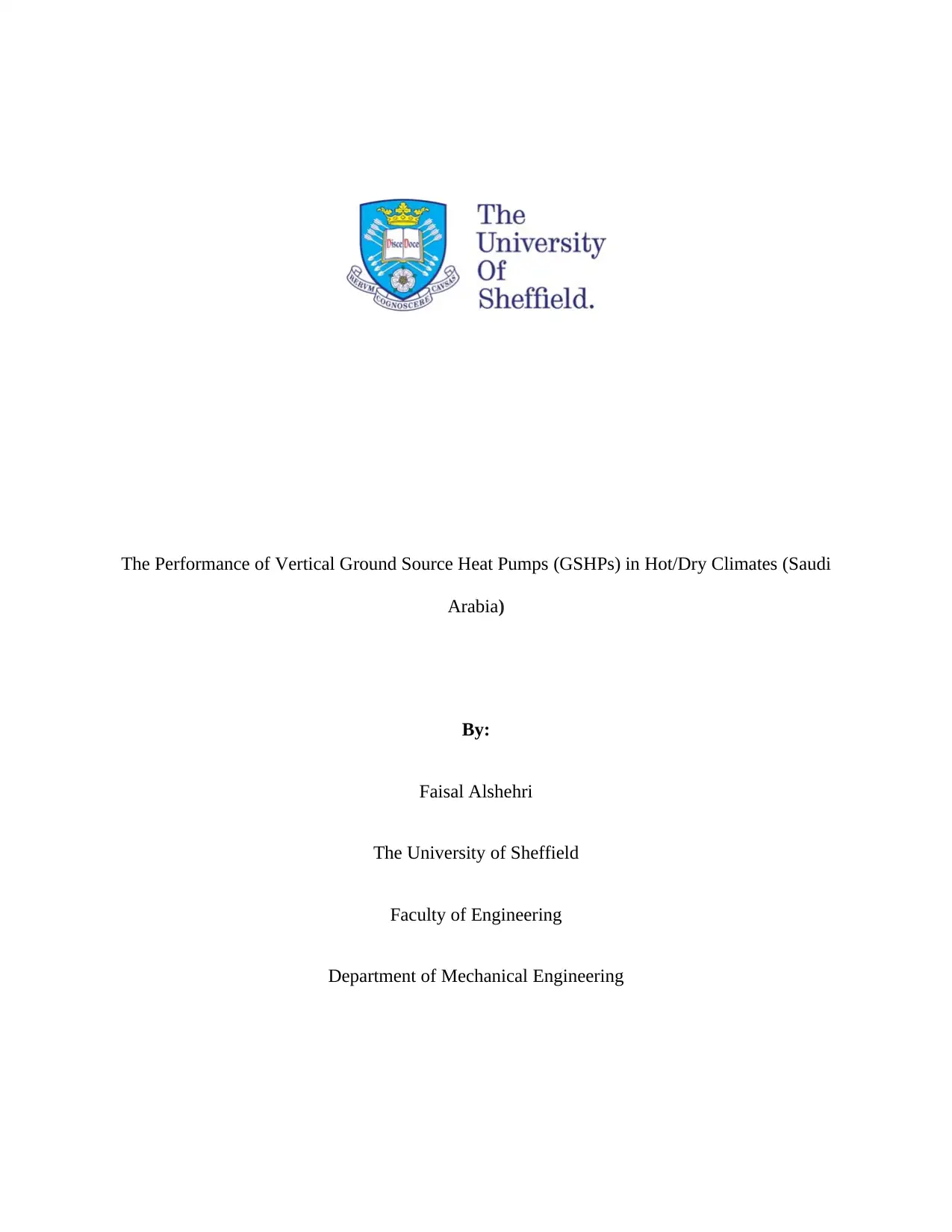
The Performance of Vertical Ground Source Heat Pumps (GSHPs) in Hot/Dry Climates (Saudi
Arabia)
By:
Faisal Alshehri
The University of Sheffield
Faculty of Engineering
Department of Mechanical Engineering
Arabia)
By:
Faisal Alshehri
The University of Sheffield
Faculty of Engineering
Department of Mechanical Engineering
Paraphrase This Document
Need a fresh take? Get an instant paraphrase of this document with our AI Paraphraser
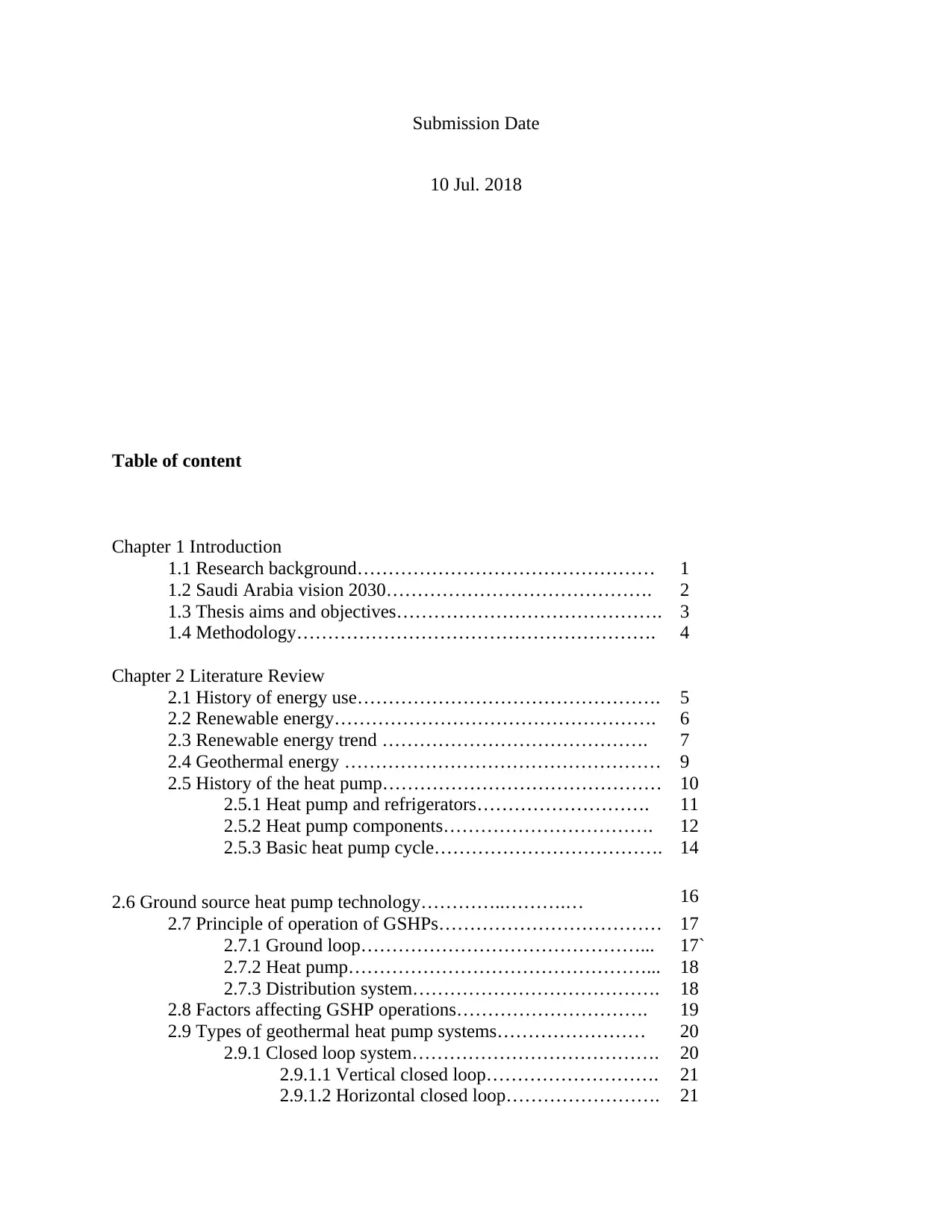
Submission Date
10 Jul. 2018
Table of content
Chapter 1 Introduction
1.1 Research background………………………………………… 1
1.2 Saudi Arabia vision 2030……………………………………. 2
1.3 Thesis aims and objectives……………………………………. 3
1.4 Methodology…………………………………………………. 4
Chapter 2 Literature Review
2.1 History of energy use…………………………………………. 5
2.2 Renewable energy……………………………………………. 6
2.3 Renewable energy trend ……………………………………. 7
2.4 Geothermal energy …………………………………………… 9
2.5 History of the heat pump……………………………………… 10
2.5.1 Heat pump and refrigerators………………………. 11
2.5.2 Heat pump components……………………………. 12
2.5.3 Basic heat pump cycle………………………………. 14
2.6 Ground source heat pump technology…………..……….… 16
2.7 Principle of operation of GSHPs……………………………… 17
2.7.1 Ground loop………………………………………... 17`
2.7.2 Heat pump…………………………………………... 18
2.7.3 Distribution system…………………………………. 18
2.8 Factors affecting GSHP operations…………………………. 19
2.9 Types of geothermal heat pump systems…………………… 20
2.9.1 Closed loop system…………………………………. 20
2.9.1.1 Vertical closed loop………………………. 21
2.9.1.2 Horizontal closed loop……………………. 21
10 Jul. 2018
Table of content
Chapter 1 Introduction
1.1 Research background………………………………………… 1
1.2 Saudi Arabia vision 2030……………………………………. 2
1.3 Thesis aims and objectives……………………………………. 3
1.4 Methodology…………………………………………………. 4
Chapter 2 Literature Review
2.1 History of energy use…………………………………………. 5
2.2 Renewable energy……………………………………………. 6
2.3 Renewable energy trend ……………………………………. 7
2.4 Geothermal energy …………………………………………… 9
2.5 History of the heat pump……………………………………… 10
2.5.1 Heat pump and refrigerators………………………. 11
2.5.2 Heat pump components……………………………. 12
2.5.3 Basic heat pump cycle………………………………. 14
2.6 Ground source heat pump technology…………..……….… 16
2.7 Principle of operation of GSHPs……………………………… 17
2.7.1 Ground loop………………………………………... 17`
2.7.2 Heat pump…………………………………………... 18
2.7.3 Distribution system…………………………………. 18
2.8 Factors affecting GSHP operations…………………………. 19
2.9 Types of geothermal heat pump systems…………………… 20
2.9.1 Closed loop system…………………………………. 20
2.9.1.1 Vertical closed loop………………………. 21
2.9.1.2 Horizontal closed loop……………………. 21

2.9.1.3 Slinky closed loop………………………… 23
2.9.1.4 Closed pond loop…………………………. 23
2.9.2 Open loop systems…………………………………. 23
2.10 Ground source heat pumps in hot and dry climates ………… 25
2.10.1 Saudi Arabia ………………………………………. 25
2.10.2 Erbil, Iraq…………………………………………. 26
2.10.3 Tunisia ……………………………………………. 27
2.10.4 Qatar………………………………………………. 28
2.10.5 Egypt ……………………………………………… 28
2.10.6 Algerian……………………………………………. 29
2.11 Conclusion…………………………………………………... 30
2.9.1.4 Closed pond loop…………………………. 23
2.9.2 Open loop systems…………………………………. 23
2.10 Ground source heat pumps in hot and dry climates ………… 25
2.10.1 Saudi Arabia ………………………………………. 25
2.10.2 Erbil, Iraq…………………………………………. 26
2.10.3 Tunisia ……………………………………………. 27
2.10.4 Qatar………………………………………………. 28
2.10.5 Egypt ……………………………………………… 28
2.10.6 Algerian……………………………………………. 29
2.11 Conclusion…………………………………………………... 30
⊘ This is a preview!⊘
Do you want full access?
Subscribe today to unlock all pages.

Trusted by 1+ million students worldwide
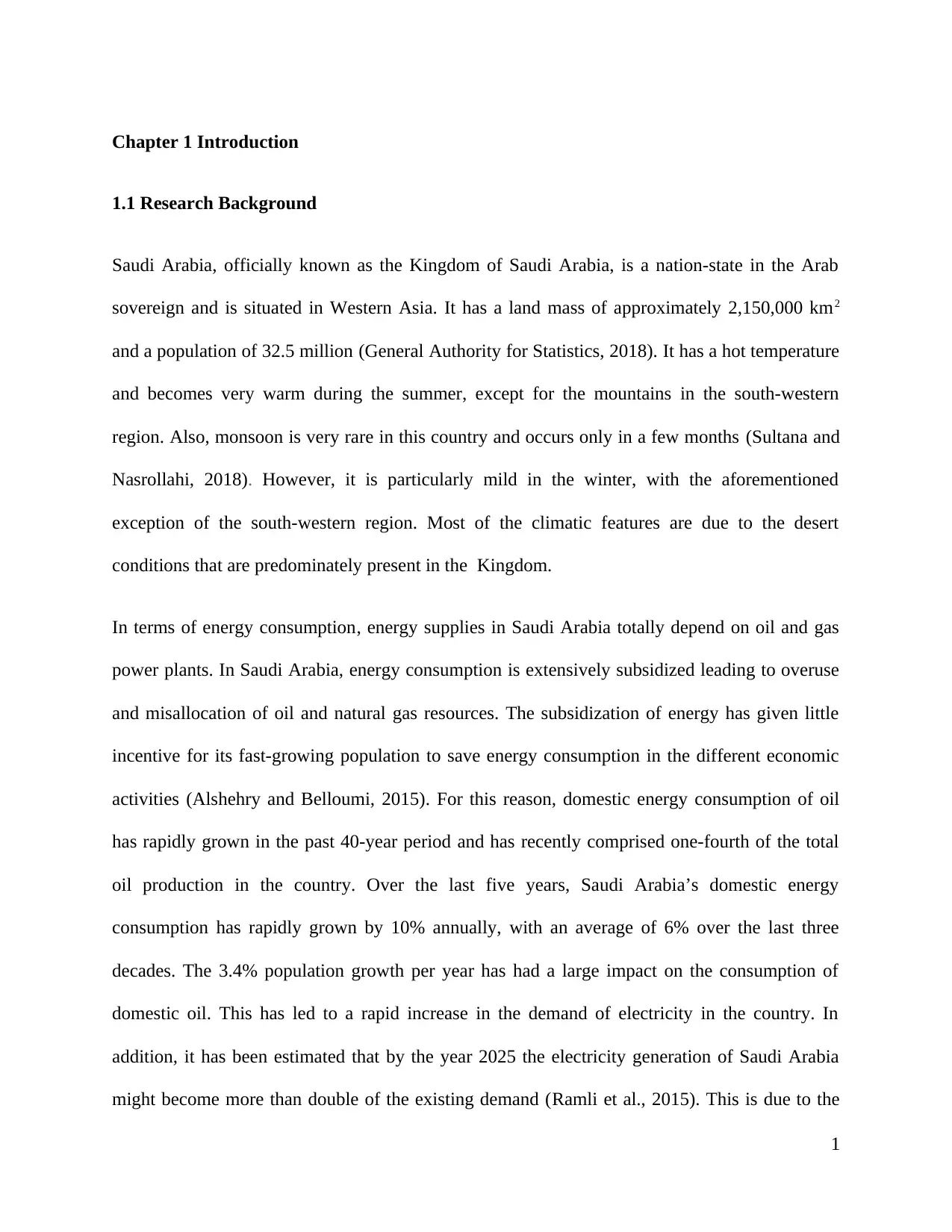
Chapter 1 Introduction
1.1 Research Background
Saudi Arabia, officially known as the Kingdom of Saudi Arabia, is a nation-state in the Arab
sovereign and is situated in Western Asia. It has a land mass of approximately 2,150,000 km2
and a population of 32.5 million (General Authority for Statistics, 2018). It has a hot temperature
and becomes very warm during the summer, except for the mountains in the south-western
region. Also, monsoon is very rare in this country and occurs only in a few months (Sultana and
Nasrollahi, 2018). However, it is particularly mild in the winter, with the aforementioned
exception of the south-western region. Most of the climatic features are due to the desert
conditions that are predominately present in the Kingdom.
In terms of energy consumption, energy supplies in Saudi Arabia totally depend on oil and gas
power plants. In Saudi Arabia, energy consumption is extensively subsidized leading to overuse
and misallocation of oil and natural gas resources. The subsidization of energy has given little
incentive for its fast-growing population to save energy consumption in the different economic
activities (Alshehry and Belloumi, 2015). For this reason, domestic energy consumption of oil
has rapidly grown in the past 40-year period and has recently comprised one-fourth of the total
oil production in the country. Over the last five years, Saudi Arabia’s domestic energy
consumption has rapidly grown by 10% annually, with an average of 6% over the last three
decades. The 3.4% population growth per year has had a large impact on the consumption of
domestic oil. This has led to a rapid increase in the demand of electricity in the country. In
addition, it has been estimated that by the year 2025 the electricity generation of Saudi Arabia
might become more than double of the existing demand (Ramli et al., 2015). This is due to the
1
1.1 Research Background
Saudi Arabia, officially known as the Kingdom of Saudi Arabia, is a nation-state in the Arab
sovereign and is situated in Western Asia. It has a land mass of approximately 2,150,000 km2
and a population of 32.5 million (General Authority for Statistics, 2018). It has a hot temperature
and becomes very warm during the summer, except for the mountains in the south-western
region. Also, monsoon is very rare in this country and occurs only in a few months (Sultana and
Nasrollahi, 2018). However, it is particularly mild in the winter, with the aforementioned
exception of the south-western region. Most of the climatic features are due to the desert
conditions that are predominately present in the Kingdom.
In terms of energy consumption, energy supplies in Saudi Arabia totally depend on oil and gas
power plants. In Saudi Arabia, energy consumption is extensively subsidized leading to overuse
and misallocation of oil and natural gas resources. The subsidization of energy has given little
incentive for its fast-growing population to save energy consumption in the different economic
activities (Alshehry and Belloumi, 2015). For this reason, domestic energy consumption of oil
has rapidly grown in the past 40-year period and has recently comprised one-fourth of the total
oil production in the country. Over the last five years, Saudi Arabia’s domestic energy
consumption has rapidly grown by 10% annually, with an average of 6% over the last three
decades. The 3.4% population growth per year has had a large impact on the consumption of
domestic oil. This has led to a rapid increase in the demand of electricity in the country. In
addition, it has been estimated that by the year 2025 the electricity generation of Saudi Arabia
might become more than double of the existing demand (Ramli et al., 2015). This is due to the
1
Paraphrase This Document
Need a fresh take? Get an instant paraphrase of this document with our AI Paraphraser
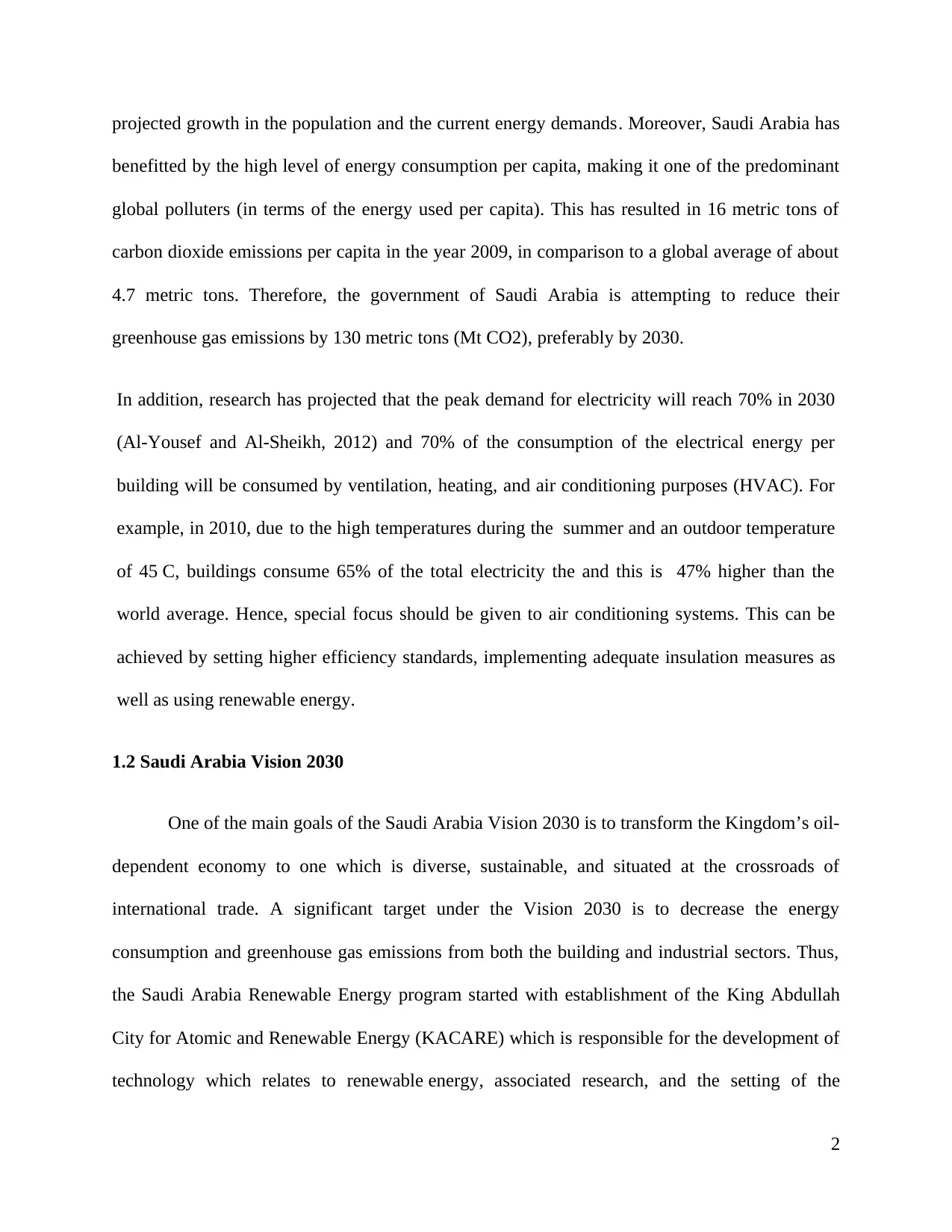
projected growth in the population and the current energy demands. Moreover, Saudi Arabia has
benefitted by the high level of energy consumption per capita, making it one of the predominant
global polluters (in terms of the energy used per capita). This has resulted in 16 metric tons of
carbon dioxide emissions per capita in the year 2009, in comparison to a global average of about
4.7 metric tons. Therefore, the government of Saudi Arabia is attempting to reduce their
greenhouse gas emissions by 130 metric tons (Mt CO2), preferably by 2030.
In addition, research has projected that the peak demand for electricity will reach 70% in 2030
(Al-Yousef and Al-Sheikh, 2012) and 70% of the consumption of the electrical energy per
building will be consumed by ventilation, heating, and air conditioning purposes (HVAC). For
example, in 2010, due to the high temperatures during the summer and an outdoor temperature
of 45 C, buildings consume 65% of the total electricity the and this is 47% higher than the
world average. Hence, special focus should be given to air conditioning systems. This can be
achieved by setting higher efficiency standards, implementing adequate insulation measures as
well as using renewable energy.
1.2 Saudi Arabia Vision 2030
One of the main goals of the Saudi Arabia Vision 2030 is to transform the Kingdom’s oil-
dependent economy to one which is diverse, sustainable, and situated at the crossroads of
international trade. A significant target under the Vision 2030 is to decrease the energy
consumption and greenhouse gas emissions from both the building and industrial sectors. Thus,
the Saudi Arabia Renewable Energy program started with establishment of the King Abdullah
City for Atomic and Renewable Energy (KACARE) which is responsible for the development of
technology which relates to renewable energy, associated research, and the setting of the
2
benefitted by the high level of energy consumption per capita, making it one of the predominant
global polluters (in terms of the energy used per capita). This has resulted in 16 metric tons of
carbon dioxide emissions per capita in the year 2009, in comparison to a global average of about
4.7 metric tons. Therefore, the government of Saudi Arabia is attempting to reduce their
greenhouse gas emissions by 130 metric tons (Mt CO2), preferably by 2030.
In addition, research has projected that the peak demand for electricity will reach 70% in 2030
(Al-Yousef and Al-Sheikh, 2012) and 70% of the consumption of the electrical energy per
building will be consumed by ventilation, heating, and air conditioning purposes (HVAC). For
example, in 2010, due to the high temperatures during the summer and an outdoor temperature
of 45 C, buildings consume 65% of the total electricity the and this is 47% higher than the
world average. Hence, special focus should be given to air conditioning systems. This can be
achieved by setting higher efficiency standards, implementing adequate insulation measures as
well as using renewable energy.
1.2 Saudi Arabia Vision 2030
One of the main goals of the Saudi Arabia Vision 2030 is to transform the Kingdom’s oil-
dependent economy to one which is diverse, sustainable, and situated at the crossroads of
international trade. A significant target under the Vision 2030 is to decrease the energy
consumption and greenhouse gas emissions from both the building and industrial sectors. Thus,
the Saudi Arabia Renewable Energy program started with establishment of the King Abdullah
City for Atomic and Renewable Energy (KACARE) which is responsible for the development of
technology which relates to renewable energy, associated research, and the setting of the
2
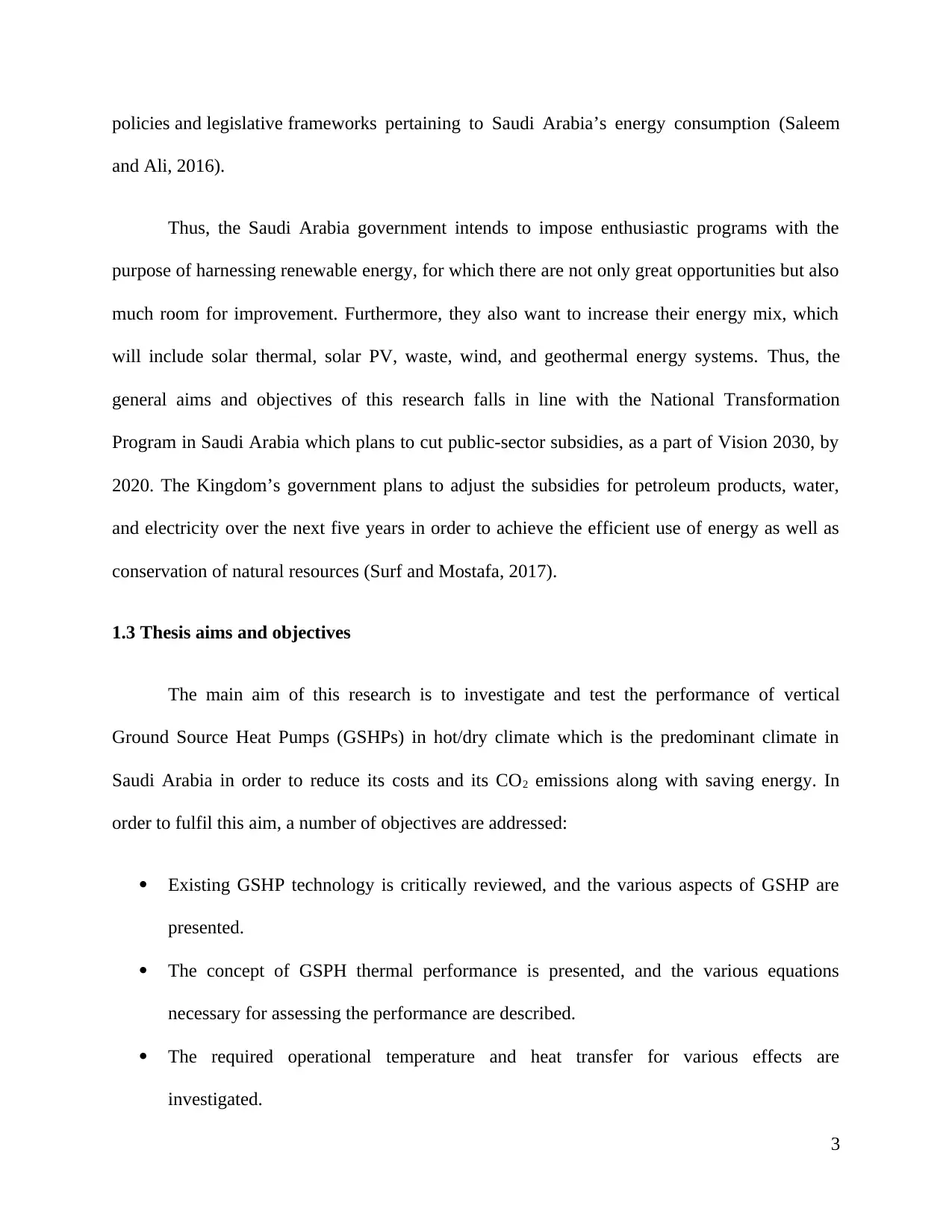
policies and legislative frameworks pertaining to Saudi Arabia’s energy consumption (Saleem
and Ali, 2016).
Thus, the Saudi Arabia government intends to impose enthusiastic programs with the
purpose of harnessing renewable energy, for which there are not only great opportunities but also
much room for improvement. Furthermore, they also want to increase their energy mix, which
will include solar thermal, solar PV, waste, wind, and geothermal energy systems. Thus, the
general aims and objectives of this research falls in line with the National Transformation
Program in Saudi Arabia which plans to cut public-sector subsidies, as a part of Vision 2030, by
2020. The Kingdom’s government plans to adjust the subsidies for petroleum products, water,
and electricity over the next five years in order to achieve the efficient use of energy as well as
conservation of natural resources (Surf and Mostafa, 2017).
1.3 Thesis aims and objectives
The main aim of this research is to investigate and test the performance of vertical
Ground Source Heat Pumps (GSHPs) in hot/dry climate which is the predominant climate in
Saudi Arabia in order to reduce its costs and its CO2 emissions along with saving energy. In
order to fulfil this aim, a number of objectives are addressed:
Existing GSHP technology is critically reviewed, and the various aspects of GSHP are
presented.
The concept of GSPH thermal performance is presented, and the various equations
necessary for assessing the performance are described.
The required operational temperature and heat transfer for various effects are
investigated.
3
and Ali, 2016).
Thus, the Saudi Arabia government intends to impose enthusiastic programs with the
purpose of harnessing renewable energy, for which there are not only great opportunities but also
much room for improvement. Furthermore, they also want to increase their energy mix, which
will include solar thermal, solar PV, waste, wind, and geothermal energy systems. Thus, the
general aims and objectives of this research falls in line with the National Transformation
Program in Saudi Arabia which plans to cut public-sector subsidies, as a part of Vision 2030, by
2020. The Kingdom’s government plans to adjust the subsidies for petroleum products, water,
and electricity over the next five years in order to achieve the efficient use of energy as well as
conservation of natural resources (Surf and Mostafa, 2017).
1.3 Thesis aims and objectives
The main aim of this research is to investigate and test the performance of vertical
Ground Source Heat Pumps (GSHPs) in hot/dry climate which is the predominant climate in
Saudi Arabia in order to reduce its costs and its CO2 emissions along with saving energy. In
order to fulfil this aim, a number of objectives are addressed:
Existing GSHP technology is critically reviewed, and the various aspects of GSHP are
presented.
The concept of GSPH thermal performance is presented, and the various equations
necessary for assessing the performance are described.
The required operational temperature and heat transfer for various effects are
investigated.
3
⊘ This is a preview!⊘
Do you want full access?
Subscribe today to unlock all pages.

Trusted by 1+ million students worldwide
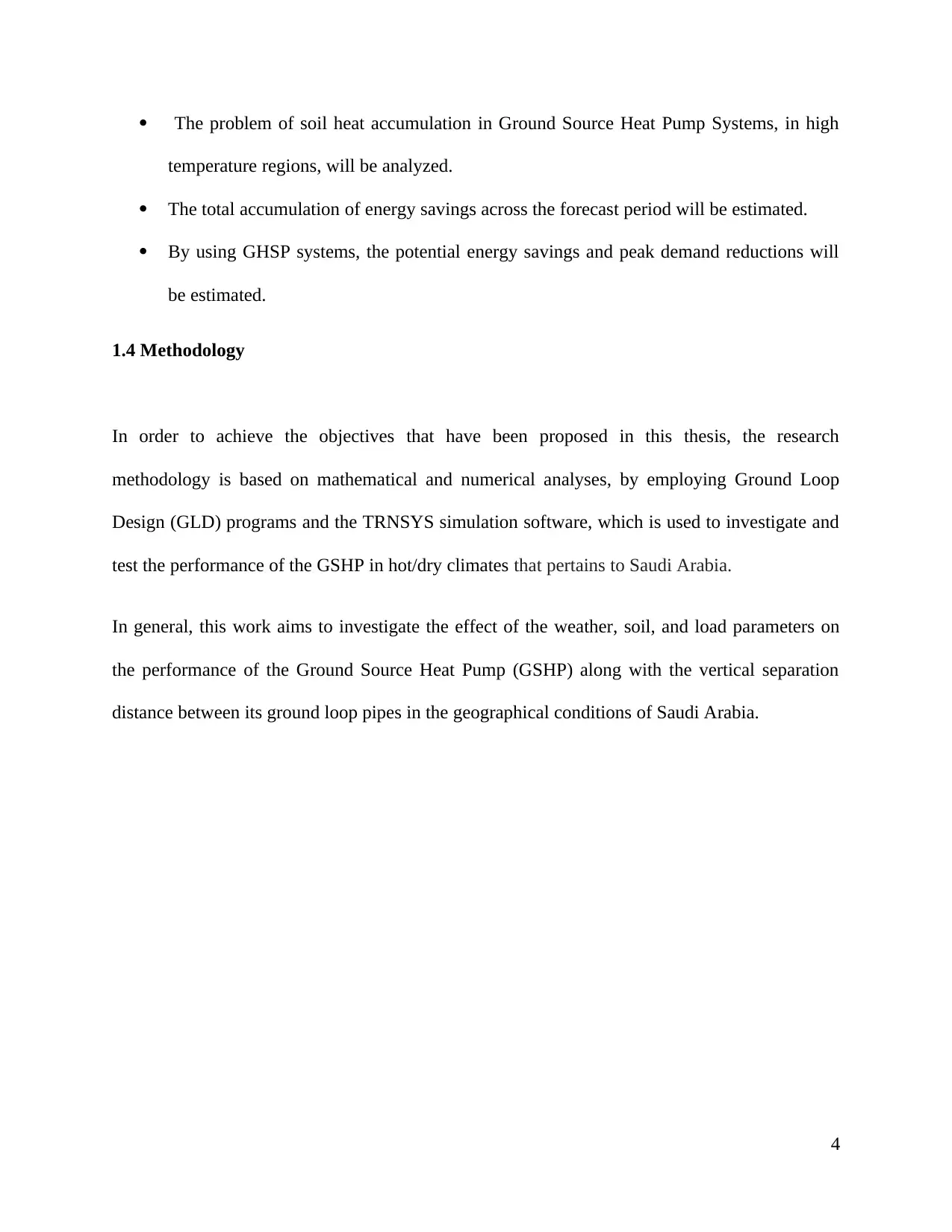
The problem of soil heat accumulation in Ground Source Heat Pump Systems, in high
temperature regions, will be analyzed.
The total accumulation of energy savings across the forecast period will be estimated.
By using GHSP systems, the potential energy savings and peak demand reductions will
be estimated.
1.4 Methodology
In order to achieve the objectives that have been proposed in this thesis, the research
methodology is based on mathematical and numerical analyses, by employing Ground Loop
Design (GLD) programs and the TRNSYS simulation software, which is used to investigate and
test the performance of the GSHP in hot/dry climates that pertains to Saudi Arabia.
In general, this work aims to investigate the effect of the weather, soil, and load parameters on
the performance of the Ground Source Heat Pump (GSHP) along with the vertical separation
distance between its ground loop pipes in the geographical conditions of Saudi Arabia.
4
temperature regions, will be analyzed.
The total accumulation of energy savings across the forecast period will be estimated.
By using GHSP systems, the potential energy savings and peak demand reductions will
be estimated.
1.4 Methodology
In order to achieve the objectives that have been proposed in this thesis, the research
methodology is based on mathematical and numerical analyses, by employing Ground Loop
Design (GLD) programs and the TRNSYS simulation software, which is used to investigate and
test the performance of the GSHP in hot/dry climates that pertains to Saudi Arabia.
In general, this work aims to investigate the effect of the weather, soil, and load parameters on
the performance of the Ground Source Heat Pump (GSHP) along with the vertical separation
distance between its ground loop pipes in the geographical conditions of Saudi Arabia.
4
Paraphrase This Document
Need a fresh take? Get an instant paraphrase of this document with our AI Paraphraser
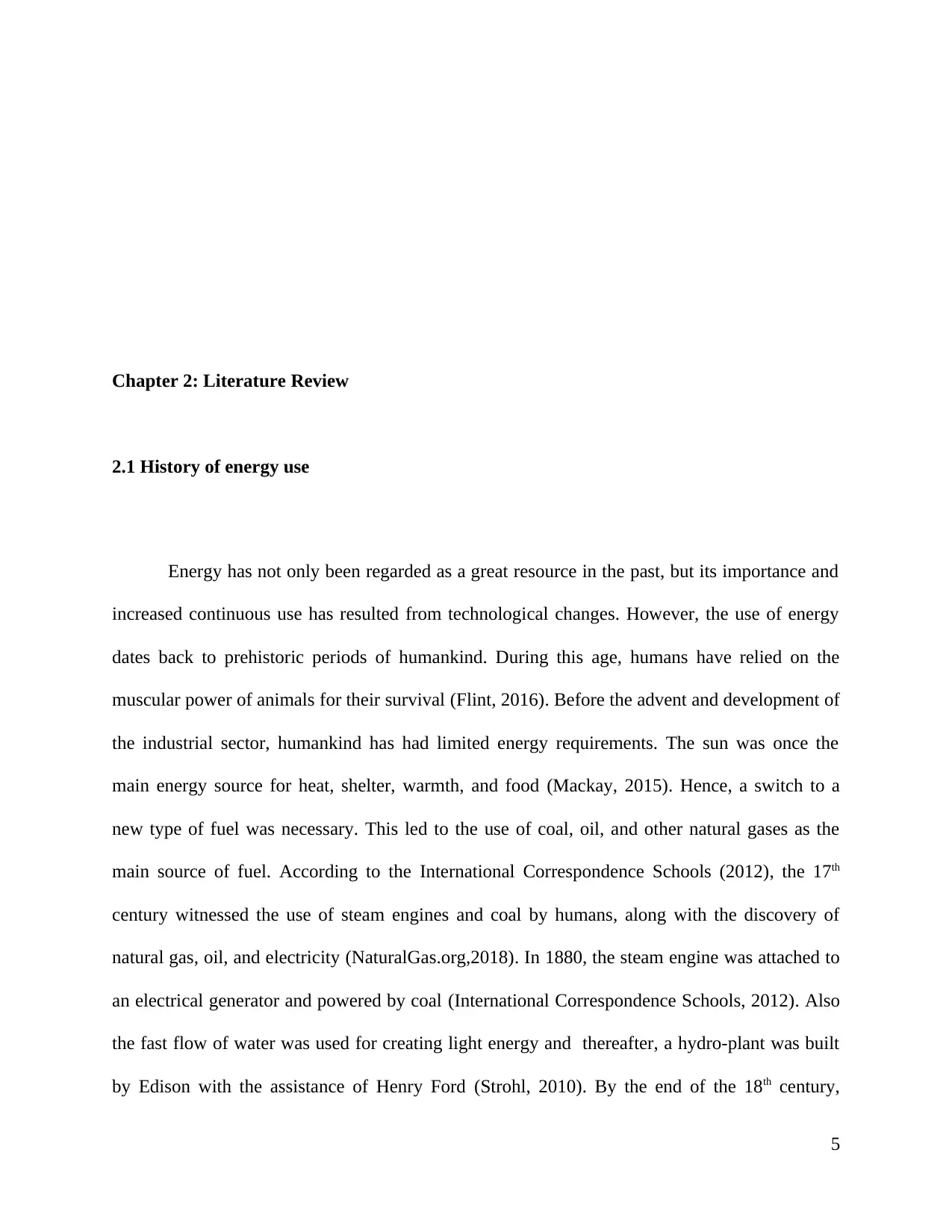
Chapter 2: Literature Review
2.1 History of energy use
Energy has not only been regarded as a great resource in the past, but its importance and
increased continuous use has resulted from technological changes. However, the use of energy
dates back to prehistoric periods of humankind. During this age, humans have relied on the
muscular power of animals for their survival (Flint, 2016). Before the advent and development of
the industrial sector, humankind has had limited energy requirements. The sun was once the
main energy source for heat, shelter, warmth, and food (Mackay, 2015). Hence, a switch to a
new type of fuel was necessary. This led to the use of coal, oil, and other natural gases as the
main source of fuel. According to the International Correspondence Schools (2012), the 17th
century witnessed the use of steam engines and coal by humans, along with the discovery of
natural gas, oil, and electricity (NaturalGas.org,2018). In 1880, the steam engine was attached to
an electrical generator and powered by coal (International Correspondence Schools, 2012). Also
the fast flow of water was used for creating light energy and thereafter, a hydro-plant was built
by Edison with the assistance of Henry Ford (Strohl, 2010). By the end of the 18th century,
5
2.1 History of energy use
Energy has not only been regarded as a great resource in the past, but its importance and
increased continuous use has resulted from technological changes. However, the use of energy
dates back to prehistoric periods of humankind. During this age, humans have relied on the
muscular power of animals for their survival (Flint, 2016). Before the advent and development of
the industrial sector, humankind has had limited energy requirements. The sun was once the
main energy source for heat, shelter, warmth, and food (Mackay, 2015). Hence, a switch to a
new type of fuel was necessary. This led to the use of coal, oil, and other natural gases as the
main source of fuel. According to the International Correspondence Schools (2012), the 17th
century witnessed the use of steam engines and coal by humans, along with the discovery of
natural gas, oil, and electricity (NaturalGas.org,2018). In 1880, the steam engine was attached to
an electrical generator and powered by coal (International Correspondence Schools, 2012). Also
the fast flow of water was used for creating light energy and thereafter, a hydro-plant was built
by Edison with the assistance of Henry Ford (Strohl, 2010). By the end of the 18th century,
5
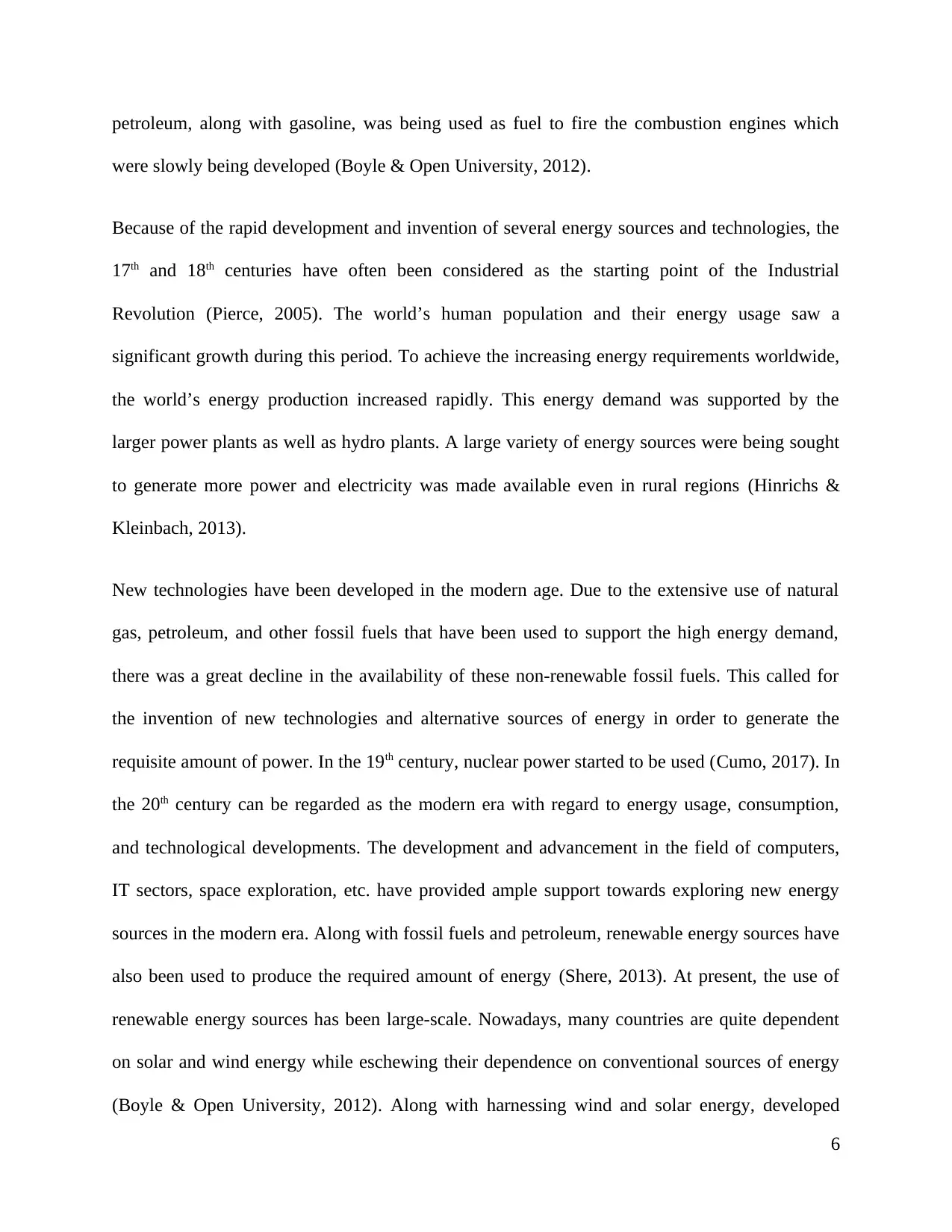
petroleum, along with gasoline, was being used as fuel to fire the combustion engines which
were slowly being developed (Boyle & Open University, 2012).
Because of the rapid development and invention of several energy sources and technologies, the
17th and 18th centuries have often been considered as the starting point of the Industrial
Revolution (Pierce, 2005). The world’s human population and their energy usage saw a
significant growth during this period. To achieve the increasing energy requirements worldwide,
the world’s energy production increased rapidly. This energy demand was supported by the
larger power plants as well as hydro plants. A large variety of energy sources were being sought
to generate more power and electricity was made available even in rural regions (Hinrichs &
Kleinbach, 2013).
New technologies have been developed in the modern age. Due to the extensive use of natural
gas, petroleum, and other fossil fuels that have been used to support the high energy demand,
there was a great decline in the availability of these non-renewable fossil fuels. This called for
the invention of new technologies and alternative sources of energy in order to generate the
requisite amount of power. In the 19th century, nuclear power started to be used (Cumo, 2017). In
the 20th century can be regarded as the modern era with regard to energy usage, consumption,
and technological developments. The development and advancement in the field of computers,
IT sectors, space exploration, etc. have provided ample support towards exploring new energy
sources in the modern era. Along with fossil fuels and petroleum, renewable energy sources have
also been used to produce the required amount of energy (Shere, 2013). At present, the use of
renewable energy sources has been large-scale. Nowadays, many countries are quite dependent
on solar and wind energy while eschewing their dependence on conventional sources of energy
(Boyle & Open University, 2012). Along with harnessing wind and solar energy, developed
6
were slowly being developed (Boyle & Open University, 2012).
Because of the rapid development and invention of several energy sources and technologies, the
17th and 18th centuries have often been considered as the starting point of the Industrial
Revolution (Pierce, 2005). The world’s human population and their energy usage saw a
significant growth during this period. To achieve the increasing energy requirements worldwide,
the world’s energy production increased rapidly. This energy demand was supported by the
larger power plants as well as hydro plants. A large variety of energy sources were being sought
to generate more power and electricity was made available even in rural regions (Hinrichs &
Kleinbach, 2013).
New technologies have been developed in the modern age. Due to the extensive use of natural
gas, petroleum, and other fossil fuels that have been used to support the high energy demand,
there was a great decline in the availability of these non-renewable fossil fuels. This called for
the invention of new technologies and alternative sources of energy in order to generate the
requisite amount of power. In the 19th century, nuclear power started to be used (Cumo, 2017). In
the 20th century can be regarded as the modern era with regard to energy usage, consumption,
and technological developments. The development and advancement in the field of computers,
IT sectors, space exploration, etc. have provided ample support towards exploring new energy
sources in the modern era. Along with fossil fuels and petroleum, renewable energy sources have
also been used to produce the required amount of energy (Shere, 2013). At present, the use of
renewable energy sources has been large-scale. Nowadays, many countries are quite dependent
on solar and wind energy while eschewing their dependence on conventional sources of energy
(Boyle & Open University, 2012). Along with harnessing wind and solar energy, developed
6
⊘ This is a preview!⊘
Do you want full access?
Subscribe today to unlock all pages.

Trusted by 1+ million students worldwide
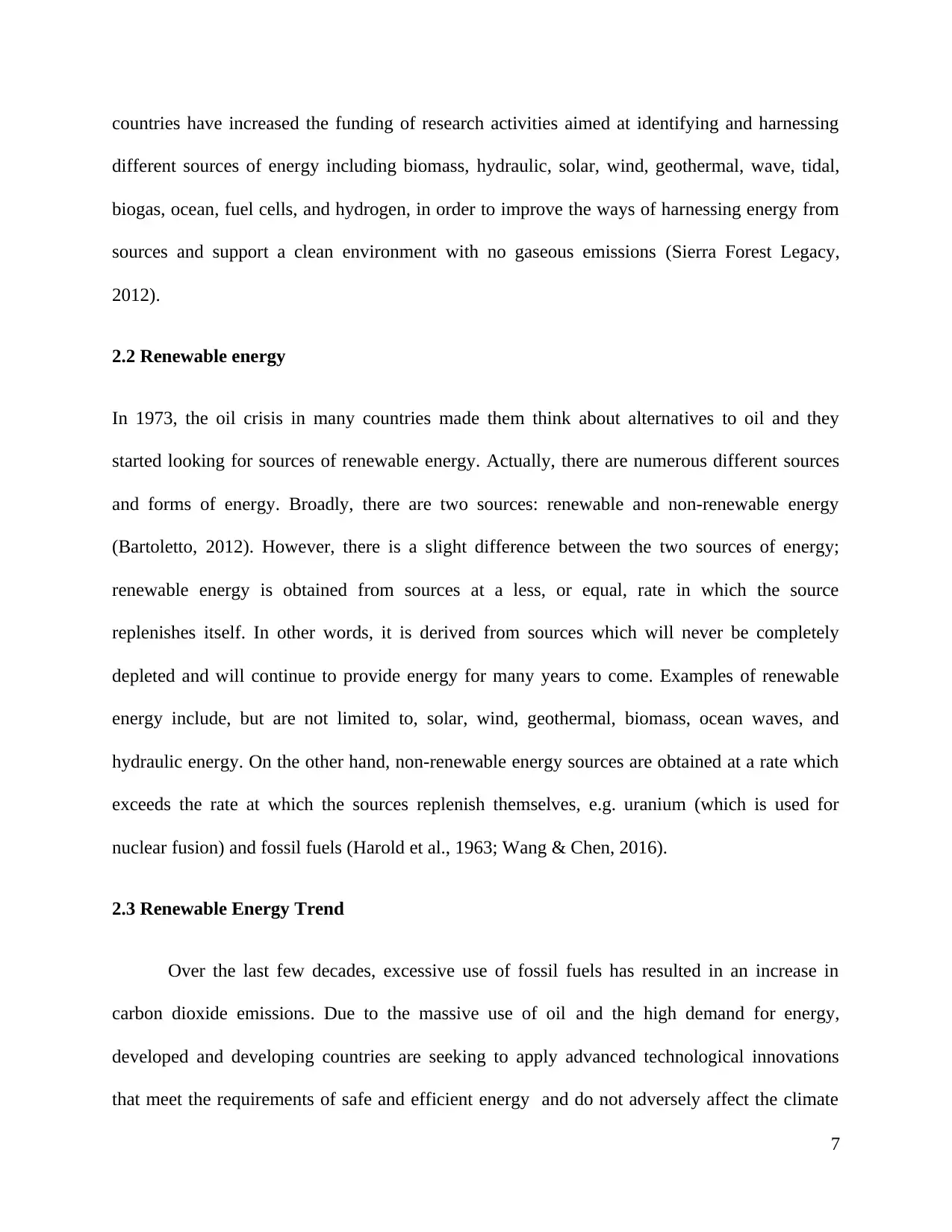
countries have increased the funding of research activities aimed at identifying and harnessing
different sources of energy including biomass, hydraulic, solar, wind, geothermal, wave, tidal,
biogas, ocean, fuel cells, and hydrogen, in order to improve the ways of harnessing energy from
sources and support a clean environment with no gaseous emissions (Sierra Forest Legacy,
2012).
2.2 Renewable energy
In 1973, the oil crisis in many countries made them think about alternatives to oil and they
started looking for sources of renewable energy. Actually, there are numerous different sources
and forms of energy. Broadly, there are two sources: renewable and non-renewable energy
(Bartoletto, 2012). However, there is a slight difference between the two sources of energy;
renewable energy is obtained from sources at a less, or equal, rate in which the source
replenishes itself. In other words, it is derived from sources which will never be completely
depleted and will continue to provide energy for many years to come. Examples of renewable
energy include, but are not limited to, solar, wind, geothermal, biomass, ocean waves, and
hydraulic energy. On the other hand, non-renewable energy sources are obtained at a rate which
exceeds the rate at which the sources replenish themselves, e.g. uranium (which is used for
nuclear fusion) and fossil fuels (Harold et al., 1963; Wang & Chen, 2016).
2.3 Renewable Energy Trend
Over the last few decades, excessive use of fossil fuels has resulted in an increase in
carbon dioxide emissions. Due to the massive use of oil and the high demand for energy,
developed and developing countries are seeking to apply advanced technological innovations
that meet the requirements of safe and efficient energy and do not adversely affect the climate
7
different sources of energy including biomass, hydraulic, solar, wind, geothermal, wave, tidal,
biogas, ocean, fuel cells, and hydrogen, in order to improve the ways of harnessing energy from
sources and support a clean environment with no gaseous emissions (Sierra Forest Legacy,
2012).
2.2 Renewable energy
In 1973, the oil crisis in many countries made them think about alternatives to oil and they
started looking for sources of renewable energy. Actually, there are numerous different sources
and forms of energy. Broadly, there are two sources: renewable and non-renewable energy
(Bartoletto, 2012). However, there is a slight difference between the two sources of energy;
renewable energy is obtained from sources at a less, or equal, rate in which the source
replenishes itself. In other words, it is derived from sources which will never be completely
depleted and will continue to provide energy for many years to come. Examples of renewable
energy include, but are not limited to, solar, wind, geothermal, biomass, ocean waves, and
hydraulic energy. On the other hand, non-renewable energy sources are obtained at a rate which
exceeds the rate at which the sources replenish themselves, e.g. uranium (which is used for
nuclear fusion) and fossil fuels (Harold et al., 1963; Wang & Chen, 2016).
2.3 Renewable Energy Trend
Over the last few decades, excessive use of fossil fuels has resulted in an increase in
carbon dioxide emissions. Due to the massive use of oil and the high demand for energy,
developed and developing countries are seeking to apply advanced technological innovations
that meet the requirements of safe and efficient energy and do not adversely affect the climate
7
Paraphrase This Document
Need a fresh take? Get an instant paraphrase of this document with our AI Paraphraser
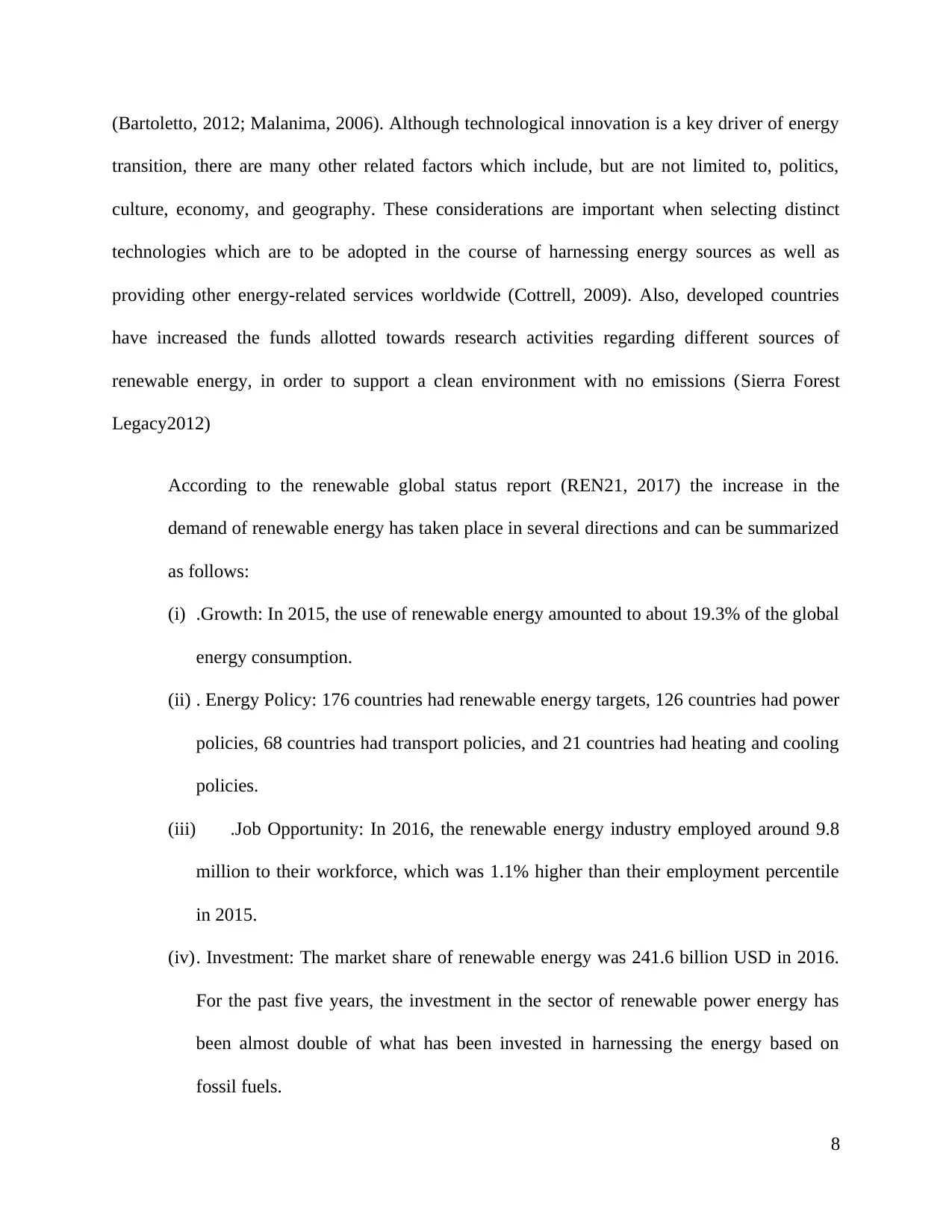
(Bartoletto, 2012; Malanima, 2006). Although technological innovation is a key driver of energy
transition, there are many other related factors which include, but are not limited to, politics,
culture, economy, and geography. These considerations are important when selecting distinct
technologies which are to be adopted in the course of harnessing energy sources as well as
providing other energy-related services worldwide (Cottrell, 2009). Also, developed countries
have increased the funds allotted towards research activities regarding different sources of
renewable energy, in order to support a clean environment with no emissions (Sierra Forest
Legacy2012)
According to the renewable global status report (REN21, 2017) the increase in the
demand of renewable energy has taken place in several directions and can be summarized
as follows:
(i) .Growth: In 2015, the use of renewable energy amounted to about 19.3% of the global
energy consumption.
(ii) . Energy Policy: 176 countries had renewable energy targets, 126 countries had power
policies, 68 countries had transport policies, and 21 countries had heating and cooling
policies.
(iii) .Job Opportunity: In 2016, the renewable energy industry employed around 9.8
million to their workforce, which was 1.1% higher than their employment percentile
in 2015.
(iv). Investment: The market share of renewable energy was 241.6 billion USD in 2016.
For the past five years, the investment in the sector of renewable power energy has
been almost double of what has been invested in harnessing the energy based on
fossil fuels.
8
transition, there are many other related factors which include, but are not limited to, politics,
culture, economy, and geography. These considerations are important when selecting distinct
technologies which are to be adopted in the course of harnessing energy sources as well as
providing other energy-related services worldwide (Cottrell, 2009). Also, developed countries
have increased the funds allotted towards research activities regarding different sources of
renewable energy, in order to support a clean environment with no emissions (Sierra Forest
Legacy2012)
According to the renewable global status report (REN21, 2017) the increase in the
demand of renewable energy has taken place in several directions and can be summarized
as follows:
(i) .Growth: In 2015, the use of renewable energy amounted to about 19.3% of the global
energy consumption.
(ii) . Energy Policy: 176 countries had renewable energy targets, 126 countries had power
policies, 68 countries had transport policies, and 21 countries had heating and cooling
policies.
(iii) .Job Opportunity: In 2016, the renewable energy industry employed around 9.8
million to their workforce, which was 1.1% higher than their employment percentile
in 2015.
(iv). Investment: The market share of renewable energy was 241.6 billion USD in 2016.
For the past five years, the investment in the sector of renewable power energy has
been almost double of what has been invested in harnessing the energy based on
fossil fuels.
8
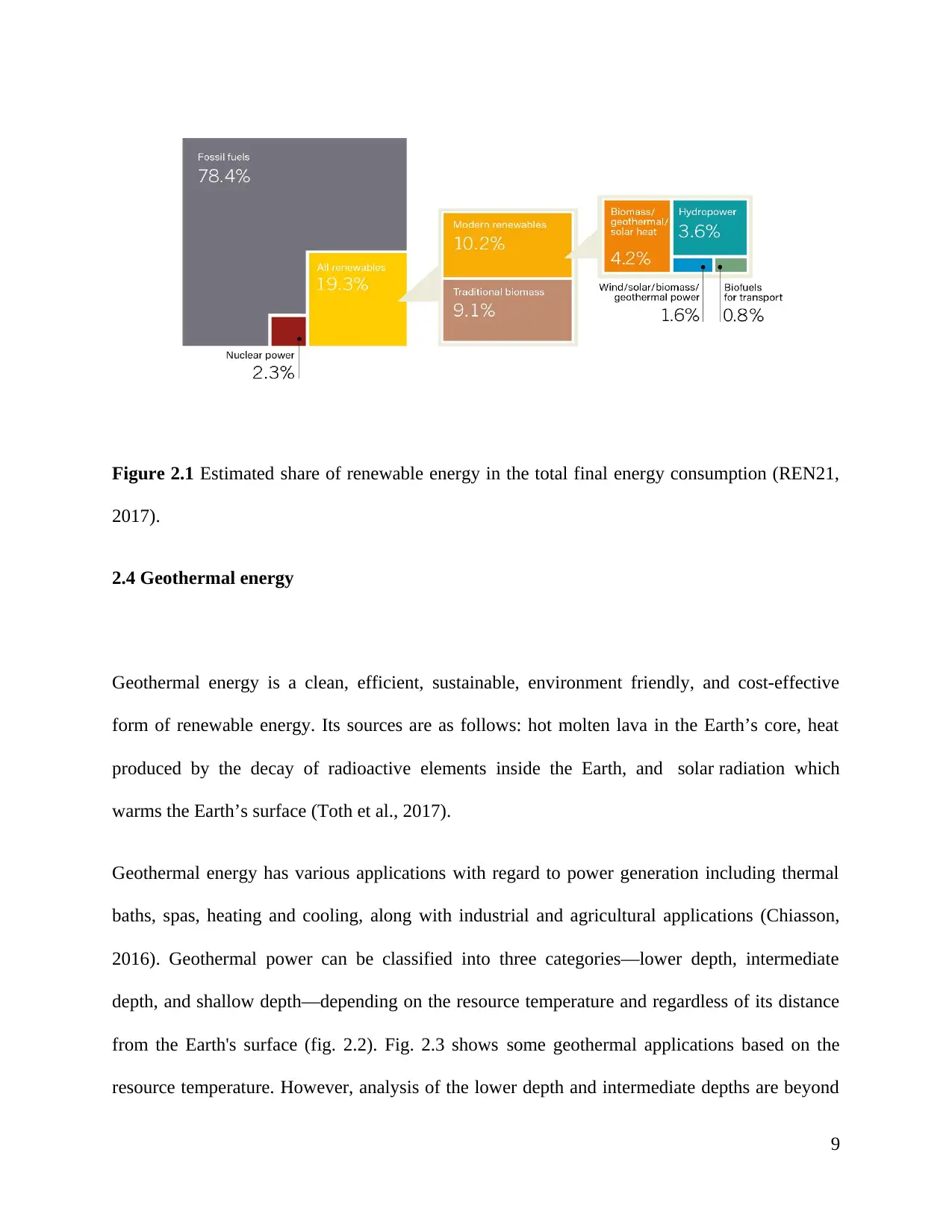
Figure 2.1 Estimated share of renewable energy in the total final energy consumption (REN21,
2017).
2.4 Geothermal energy
Geothermal energy is a clean, efficient, sustainable, environment friendly, and cost-effective
form of renewable energy. Its sources are as follows: hot molten lava in the Earth’s core, heat
produced by the decay of radioactive elements inside the Earth, and solar radiation which
warms the Earth’s surface (Toth et al., 2017).
Geothermal energy has various applications with regard to power generation including thermal
baths, spas, heating and cooling, along with industrial and agricultural applications (Chiasson,
2016). Geothermal power can be classified into three categories—lower depth, intermediate
depth, and shallow depth—depending on the resource temperature and regardless of its distance
from the Earth's surface (fig. 2.2). Fig. 2.3 shows some geothermal applications based on the
resource temperature. However, analysis of the lower depth and intermediate depths are beyond
9
2017).
2.4 Geothermal energy
Geothermal energy is a clean, efficient, sustainable, environment friendly, and cost-effective
form of renewable energy. Its sources are as follows: hot molten lava in the Earth’s core, heat
produced by the decay of radioactive elements inside the Earth, and solar radiation which
warms the Earth’s surface (Toth et al., 2017).
Geothermal energy has various applications with regard to power generation including thermal
baths, spas, heating and cooling, along with industrial and agricultural applications (Chiasson,
2016). Geothermal power can be classified into three categories—lower depth, intermediate
depth, and shallow depth—depending on the resource temperature and regardless of its distance
from the Earth's surface (fig. 2.2). Fig. 2.3 shows some geothermal applications based on the
resource temperature. However, analysis of the lower depth and intermediate depths are beyond
9
⊘ This is a preview!⊘
Do you want full access?
Subscribe today to unlock all pages.

Trusted by 1+ million students worldwide
1 out of 43
Your All-in-One AI-Powered Toolkit for Academic Success.
+13062052269
info@desklib.com
Available 24*7 on WhatsApp / Email
![[object Object]](/_next/static/media/star-bottom.7253800d.svg)
Unlock your academic potential
Copyright © 2020–2025 A2Z Services. All Rights Reserved. Developed and managed by ZUCOL.